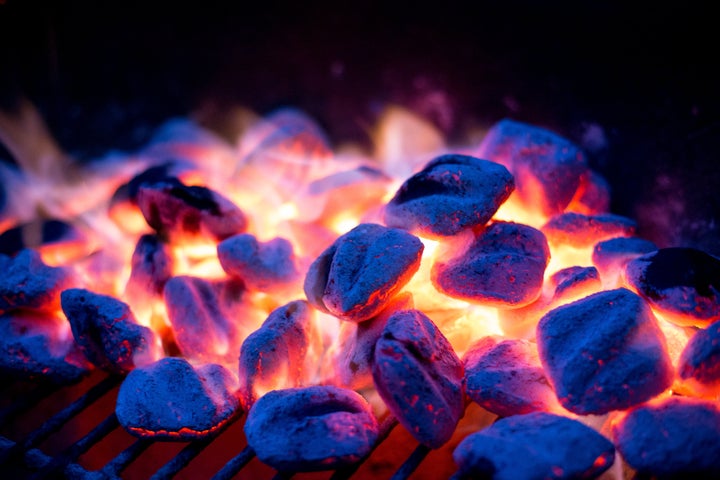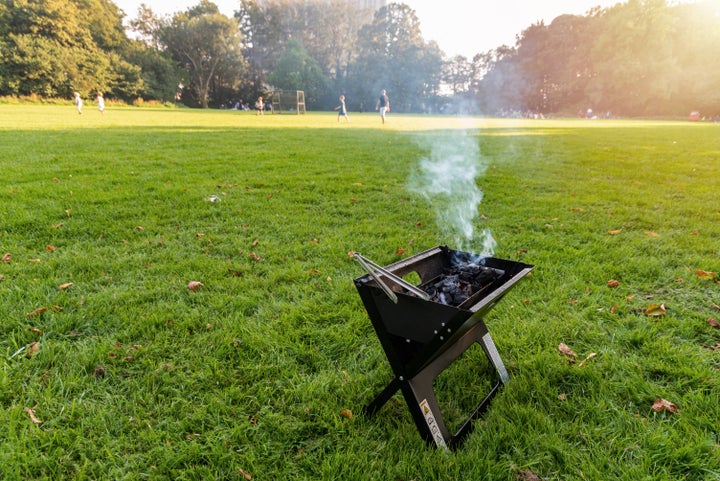If you grill with charcoal, you especially need to listen up.
While the perks of outdoor grilling are legion, it can leave behind some less-than-appealing effects on the environment. Studies show that charcoal grills in particular release substantial carbon dioxide into the air with each use, and the cumulative effect of these greenhouse gasses contributes to global warming and climate change.
Also, demand for charcoal (which is made from burnt wood) can promote deforestation and release further greenhouse emissions from the charcoal-making process (the burning of large quantities of wood produces carbon dioxide, carbon monoxide and methane).
All of this together can diminish the goal that chef Sarah Glover recommends for all outdoor grillers: “Leave the space better than you found it and never take for granted what you get from being outdoors.”
To find out how to have an enjoyable summer barbecue while causing the least-possible damage to your natural surroundings, we asked professional grill chefs and eco-conscious cookware experts to give us their top tips on eco-friendly grilling.
Seek out high-quality pure lump charcoal.
Charcoal briquettes are popular among home grillers, since they’re easy to light without the aid of lighter fluid and provide even heat to the grill. However, these composite chunks, which contain wood chips and sawdust, are often held together with chemical additives that extend their burn time and help them maintain their shape. Those additives also can release additional emissions into the air.
Chef Luis Mata doesn’t recommend briquettes for eco-conscious cooking. Instead, he said that “the key to making your charcoal grilling experience more eco-friendly is to use the highest quality lump charcoal you can get your hands on.”
“Lump charcoal” is exactly what it sounds like: lump-shaped pieces of charcoal that haven’t been chemically processed or shaped. It tends to be the preferred charcoal of barbecue pros, who cite the fact that it lights quickly, burns hot and leaves behind less residual ash than briquettes.
For an especially solid lump charcoal that’s better for the environment, Mata recommends Binchotan, “a Japanese crafted hardwood lump charcoal that’s known as the purest in the world. It burns longer, hotter and cleaner than any other charcoal or briquette. It’s also smokeless and odorless, and can be reused.”
Steer clear of lighter fluid.
Charcoal (particularly lump charcoal) generally requires a fire starter to light. While petroleum lighter fluid is popular for this purpose, the experts we spoke to generally advise against it.
“Lighter fluid is made of hydrocarbons, which can be toxic if ingested and could cause symptoms such as stomach or throat pain, vomiting, difficulty breathing and skin or eye irritation,” said Ben Jablonski, CEO and co-founder of The Good Charcoal. “Furthermore, the smoke given off by lighter fluid-soaked coals contributes to air pollution.”
The University of Illinois Sustainable Technology Center backs up these claims, stating that “lighter fluid causes air pollution, such as polycystic aromatic hydrocarbon, when burned.”
Pima County, Arizona, issued a warning about the use of lighter fluid on grills in 2016, noting that, when “mixed with intense solar radiation and other pollutants, the chemicals in lighter fluid create a pollutant called ground-level ozone. Elevated levels of ground-level ozone can affect children, people who work or exercise outside, the elderly and people with lung or heart disease, including asthma and congestive heart failure.”
Health issues that can come from ground-level ozone exposure include coughing, difficulty breathing and heightened vulnerability of the lungs, according to the U.S. Environmental Protection Agency.
Glover recommends using “natural fire lighter fluids — or, even better, get an ax and split your own wood into small kindling so you don’t have to use fire-lighting fluid at all.”
If you’re using kindling, invest in a charcoal chimney starter to speed along the charcoal-lighting process.

If possible, switch to a natural gas grill.
Charcoal grills have a serious cult following among grilling enthusiasts, but they’re not the only game in town. If you want to really optimize your eco-friendly grilling practices, consider ditching the charcoal in favor of a natural gas grill. Because of their very low emissions, wide availability and moderate price point, the Sierra Club calls natural gas grills “the most realistically eco-friendly option” for most home grillers.
Prevent flare-ups with catch pans or aluminum foil.
Fire breakouts on a grill can be alarming for many reasons, but an underrated one involves the fact that they release more smoke — and, therefore, more toxins — than necessary into the environment, according to chef Ron Stewart.
To lessen the risk of flare-ups, take Stewart’s advice and “put aluminum foil below your meat so that any dripping fat does not land directly on the coals/embers. You should also consider either investing in an inexpensive catch pan designed for catching grease drippings or using a heavy-duty aluminum foil tray underneath your food during cooking to safely collect excess fats before they fall onto coals/burner elements.”

Shut down the grill as soon as you’re done cooking.
For an easy way to cut back on emissions, turn off the grill as soon as your food is ready.
“When using charcoal, most people will let their coals burn down and out when done cooking, which can take hours,” Jablonski said. “The result is hours of charcoal emissions emitted with no further purpose. The solution is quite simple: When you are done cooking, simply close the lid to the grill and shut any vents or baffles. This will very quickly stifle the lit coals and leave a basket of slightly used charcoal ready for your next grilling encounter.”
Briquettes should be thrown in the garbage, but lump charcoal can be repurposed as fertilizer.
While briquettes with synthetic materials should be thrown in landfill garbage after use, Jablonski told us that lump charcoal can often be reused if it hasn’t burned down completely. But after the second grill cycle, it’s time to figure out where to dispose of those residual bits and ash.
Jablonski has a simple and eco-friendly solution: “As long as you use an additive-free wood charcoal, you can use it as fertilizer. The ash contains potash (potassium carbonate), which is nutritious for many plants. Potash can also increase the pH levels in your soil, but depending on what you’re growing, you want to use it sparingly. Don’t use charcoal ash with acid-loving plants (like blueberries, azaleas and hydrangeas), nor newly planted seedlings and seeds.”
As an alternative, Jablonski said that tossing a few pieces of used lump charcoal into your compost pile can help the entire composting process.
“Charcoal increases the carbon content” of the compost pile, he said. “Carbon is important to provide energy to microorganisms while they break down the organic matter in compost.”
Credit: Source link